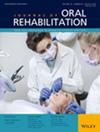Masticatory Performance Within a Representative Swiss Cohort: A Cross-Sectional Study
Abstract
Background
Masticatory function is a major indicator for oral health status. At the time being, only few studies have investigated orofacial functional conditions with different methods.
Objective
To assess the masticatory performance (MP) of individuals aged ≥ 45 residing in Swiss communities by means of a a two-colour chewing gum.
Methods
Subjects aged ≥ 45 years and residing in Swiss communities (Bern-Canton) were recruited for this cross-sectional study. After a comprehensive clinical examination and subjects' data collection thorough dedicated questionnaires, a two-colour mixing-ability test was carried out. The photographed specimens were analysed with a subjective (SA) and an Opto-Electronic assessment (SD_Hue). Descriptive, bivariate analysis and multinomial logistic regression were performed between the outcome variable (SA) and subjects' variables.
Results
From the whole analysed sample (275 patients; male n = 154, women n = 121, mean age = 69.7 years), MP was assessed on 207 chewing samples. The SA revealed 118 (57%) categorised as SA 4—SA 5 (very good), 76 (36.7%) as SA 3 (good) and 13 (6.3%) as SA 1 and SA 2 (poor), respectively. MP was higher in the younger (age 45–64, SD_Hue: 0.09 SD 0.89) than in older group (age ≥ 75 years, SD_Hue: 0.19 SD 0.18). A significant association between MP and age (p < 0.01), time to the last visit at the dentist, visit to the dental hygienist (p = 0.03; p = 0.01) as well as the use of dental floss (p < 0.01) were detected.
Conclusion
MP of individuals aged ≥ 45 residing in Swiss communities was overall good. High plaque and bleeding scores were increasing with subjects' age.

 求助内容:
求助内容: 应助结果提醒方式:
应助结果提醒方式:


